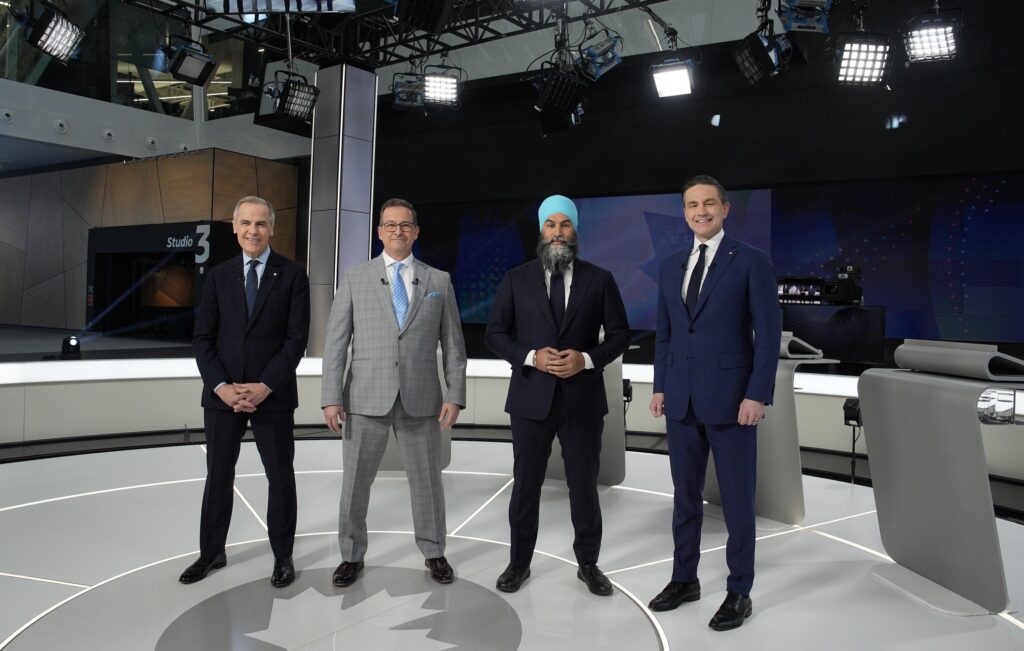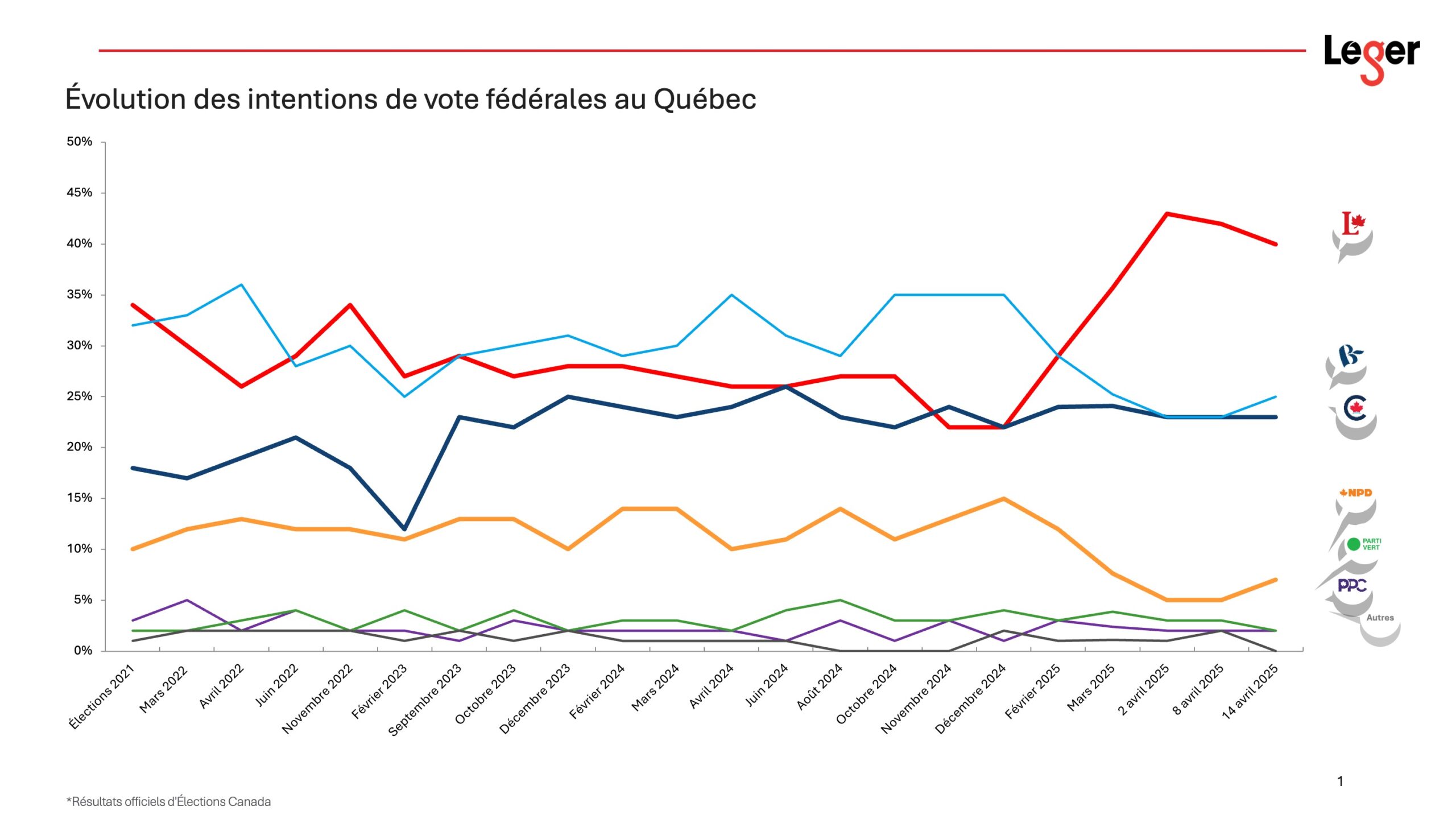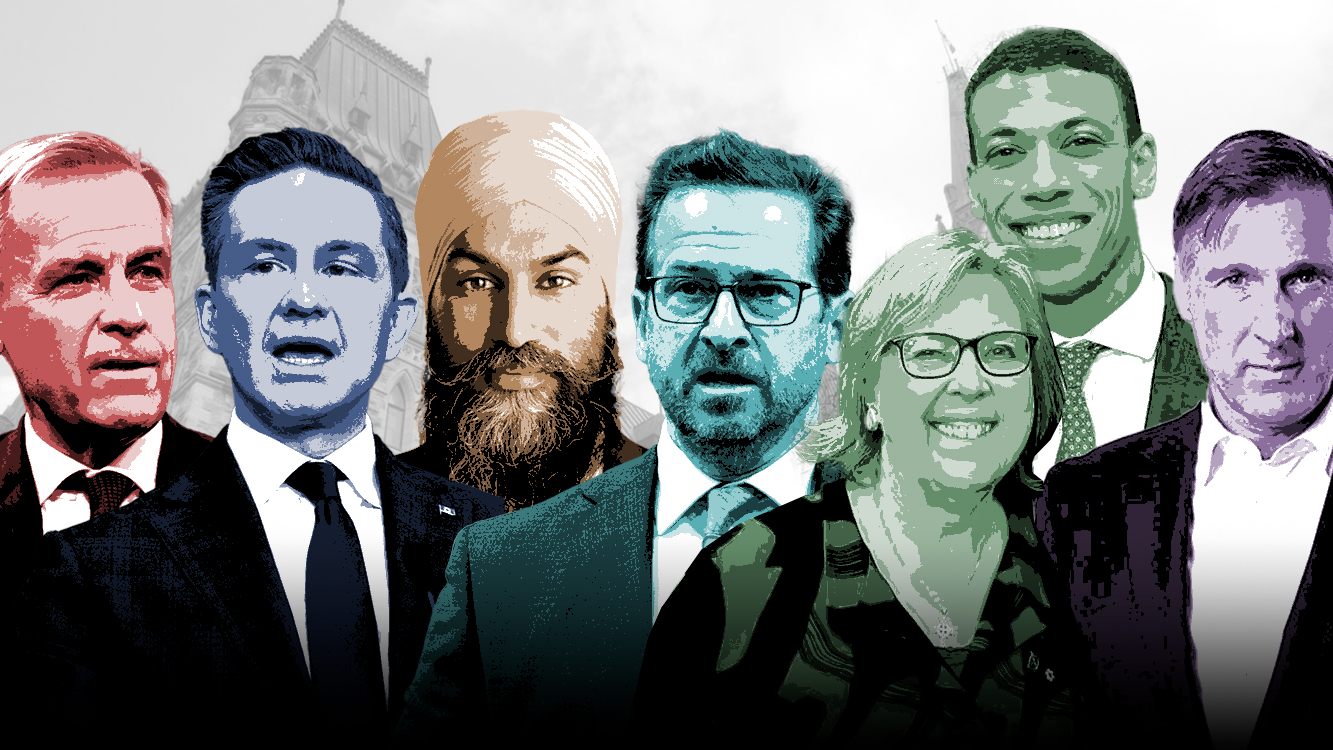Make sure to get this weekly election report straight to your inbox!
All party leaders spent Week 4 of the campaign in Quebec, as they pre-positioned and prepared for the French and English-language leaders’ debates in Montreal on Wednesday and Thursday.

The French language debate
As the front runner in the current campaign, Liberal leader Mark Carney had to prove he could survive the onslaught of the other three leaders and hold his own in French. He succeeded on both fronts. While he appeared reticent at first and slow to engage, he became more active as the debate wore on, and none of the punches from the other leaders really landed. Pressed repeatedly on the Liberal record, he responded, “I just arrived (and) I’m not Justin Trudeau either” bridging to his accomplishments since becoming prime minister and the ballot question: “The question in this election is who is going to succeed? Who is going to face Mr. Trump?”
As expected, Pierre Poilievre’s approach to the debate was more subdued than he has been on the campaign trail, with little of the combativeness for which he is known. On the central issue of the campaign, he said, “No one can control Donald Trump, but we can control our domestic economy by reversing the economic policies that the Liberals brought in that weakened our economy.” He was also firm in his support for pipelines, saying to Yves-Francois Blanchet, “You say you’re in favour of sovereignty. I’m in favour of economic sovereignty and energy sovereignty and that requires a pipeline across Canada.” Appealing for support in Quebec, Poilievre promised to give the Quebec government more powers over immigration policy.
For Blanchet and NDP leader Jagmeet Singh, the stakes in the debate were high, as the Trump-dominated ballot question has caused a precipitous drop in their parties’ public support. Both were feisty and aggressive, working hard to force their way into the national election conversation. They also spent significant time attacking Poilievre, which seemingly eased the pressure on Carney.
At one point, Jagmeet Singh fought with debate moderator Patrice Roy over Singh’s insistence on discussing health care, which was not formally a debate topic. After Roy cut off his microphone, Singh attacked him, saying “During this debate, I tried to raise the question of health a few times and Mr. Roy stopped me several times. Look at the time on the clock”. As the National Post noted, “The clock indeed showed that Singh had spoken the least out of all the four leaders on stage at 18:46 minutes. In comparison, the others were closer to 22 or 23 minutes.”
Finally, moderator Roy took all parties to task for not having published fully costed platforms prior to the debates. Carney responded that the Liberal platform would be out on the weekend while Poilievre said the Conservatives would release theirs in the coming days.
In summary, most media observers agreed, that with no mistakes or knockouts, if there was a “winner” in this debate it was Carney, in that he “won by not losing”.
Focus on Quebec
Heading into the 2025 election, the seat distribution in Québec was a three-way split with the Bloc Québécois holding 34 seats, the Liberals 33, the Conservative Party 10, and the NDP, 1. The 2022 federal redistribution process maintained the status-quo in Québec, giving the province a total of 78 electoral seats.
When Justin Trudeau announced his intention to resign on January 6th, 2025, the Conservatives were ahead of the Liberals by roughly 26 points nationally; but in Quebec, the shortcomings of the Liberals translated to a significant lead for the Bloc Québécois. Provincial polling placed the Bloc at roughly 37% in January, followed by the Conservatives at 25%, the Liberals at 22%, and the NDP at 10%.

According to seat projections from early January, the Bloc were positioned to win up to 45 seats in 2025, putting them in the running for Official Opposition.
Support for the Bloc has since melted away. Trade tensions with the United States have become the dominant issue in Canada, making the Liberals competitive in Quebec once again, predominantly in Montreal’s southern suburbs. The most recent polling from Leger placed the Liberals at 40%, followed by the Bloc at 25%, the Conservatives at 23%, and the NDP at 7%.
Projections for the Conservatives have remained relatively stable and are not expected to allow for any serious increase in seats. The Conservatives still maintain their hold on seats in Quebec City and the south shore of the St-Lawrence River. The NDP is looking to keep its only seat in the Montreal riding of Rosemont—La Petite-Patrie.
Three regional votes in Québec
The Liberals have traditionally been dominant on Montréal Island, the Conservatives strong around Québec City, and the Bloc Québécois maintaining their strongholds in many francophone and rural regions. This election presented an opportunity for the Conservatives to expand beyond their Québec City base, while the Bloc seeks to challenge the Liberals in Montréal and its suburbs, as signalled by their 2024 by-election win in LaSalle-Émard-Verdun. The renewed sense of momentum for the Liberal Party across the province means that many of these races could be shaped by local dynamics and candidate strength.
Battleground ridings
Trois-Rivières is shaping up to be a highly competitive race, with Bloc Québécois incumbent Yves Perron, Conservative Yves Lévesque and Liberal Caroline Desrochers all in the running. Desrochers, who entered the race on day 10, still leads with 33%, followed closely by Perron at 30% and Lévesque, the former mayor of Trois-Rivières, in third position at 27%. Trois-Rivières was named among the top nine cities most likely to feel the impact of the tariffs. In fact, the city has been impacted by tariff-related challenges for decades in its steel, aluminum and forestry sectors. The rising cost of living could emerge as a key concern for local voters.
In Beauport, Conservative candidate and radio-host Hugo Langlois leads with 34%, followed by Liberal Steeve Lavoie at 30% and the Bloc Québecois incumbent Julie Vignola in third at 26%. The proposed third link transportation corridor, championed by the Conservatives in contrast to the Liberals’ support for the Québec City Tramway, could prove to be a key issue in the outcome of the race.
The riding of Saguenay has so far remained favourable to the Conservatives, with incumbent Richard Martel leading with 40%. Liberal candidate Stéphane Proulx follows at 28% and the Bloc Québécois candidate and former general director of Le Quotidien Marc St-Hilaire at 26%. This riding is the only one in the region currently held by a federalist party, with the Bloc Québécois holding all neighbouring seats.
The region had previously held economic hopes tied to LNG Québec’s proposed liquification plant in La Baie, only to see the project rejected by the provincial government in 2021. Over the course of the campaign, Conservative leader Pierre Poilievre has visited the region, promising to speed up permitting for major projects, an appeal that could resonate with voters focused on economic growth.
Despite a national collapse in NDP support, Berthier-Maskinongé could prove to be an exception. The race is extremely tight, with Liberal Stéphane Bilodeau, the NDP’s Ruth Ellen Brosseau, and Bloc Québécois incumbent Yves Perron all polling at 28%. Brosseau, who represented the riding until 2019, is seeking a comeback after narrow losses in the past two elections, coming close in 2021. Housing and tax policy will be at the forefront of this race, as the region has faced an increase in homelessness as well as affordability challenges.
Battles over the ballot question persist
Concerns related to affordability and cost of living remain top of mind, but a significant portion of Quebecers view Trump as both an existential threat and a key factor dictating voter preferences in the 2025 election.
The Bloc recently aligned itself with the provincial government by endorsing Premier Legault’s list of key issues and requests from federal parties. In his letter of March 27, Legault called for a 50% reduction in temporary immigration over three years; provincial control over the selection of temporary workers; protection of key pillars of Quebec’s economy such as agri-food and supply management, aerospace and culture during future trade negotiations with the U.S.; and support for major infrastructure investments. The letter also emphasized the importance of language, identity, and economic prosperity.
Identity and language have historically been key issues for the Bloc, and throughout the campaign, Yves-François Blanchet has attempted to demonstrate his strengths on that front, while pivoting to acknowledge Canada-U.S. issues and their impact on Quebec’s economy. Despite this, 41% of Quebecers are currently expected to favour Mark Carney as their choice for Prime Minister.
A disconnect remains between domestic issues such as affordability, cost of living, and housing, felt by voters in their daily lives, and foreign policy issues such as tariffs and sovereignty. In communities across rural and industrial regions of Quebec, local economic conditions have been identified as most pressing in the upcoming election. It remains to be seen if fear and uncertainty towards the U.S. will be the dominant motivator in this election, and enough to solidify support for Carney. Quebecers remain split nearly evenly, with 44% having hope for a better future and 40% fearing what the future may hold in the face of conflict with the U.S.
Conclusion
Quebec is Canada’s second most populous province, and its influence on the election outcome should not be underestimated. With 122 seats, vote-rich Ontario is viewed as the key to victory in 2025, but success in Quebec could dictate whether this takes the form of a majority or a minority government.
The debates, the ability of local candidate to get the vote out, and evolving issues such as the cost of living, economic development and tariffs will all play pivotal roles in the final weeks of the campaign. There is a precedent and potential for a resurgence in Bloc support following the debates, as in 2021 when Quebec voters shifted their votes in favour of Blanchet following perceived slights on Quebec during the anglophone leaders’ debate. This time around, Blanchet appeared successful in making his case to nationalist voters, while Carney occasionally struggled to respond in French at times, often defaulting to his basic talking points.
This campaign cycle has also introduced new variables. Tariffs and imperialist musings from the U.S. have triggered a national conversation about identity and unity – and these conversations have been taking place in Quebec as well. Based on Wednesday’s French language debate, there appears to be a lack of consensus on what the Canadian identity represents. There does appear to be common ground in the manner in which Canadians and political leaders define our identity in terms of our sovereignty vis-à-vis the U.S. Time will tell if it is enough to unite the “two solitudes” of French and English Canada, at least for the purposes of this campaign.
Insights in this piece contributed by Daniel Bernier, Delaney Cullinan, and Victoria LaChance.
